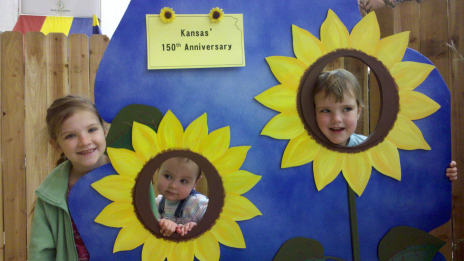
I can’t get enough of our local garden show; thankfully I was able to spend two days taking it all in. The heart of the show are spectacular displays of full grown trees, shrubs, and flowers massed together in large architectural landscapes created by local garden and landscape businesses. There are educational booths, seminars and plenty of flowers, pots and garden items for purchase.
The Extension Master Gardener booth had a great photo spot for the girls. We all giggled as they posed with the sunflowers (notice everyone looking in a different direction). The girls were given sunflower seeds at the master gardener booth; as soon as we got home, my middle daughter had her garden gloves on and was begging to plant her sunflower seeds. I halted her plans and explained it was way too cold for her little sunflower seeds. I had to promise we would plant them when the time was right.
Before we even consider planting our sunflower seeds, we must do some garden preparation. In the past two blogs, I spent time discussing the importance of nitrogen and phosphorus. This week I will tackle the last (but equally important) of the three primary soil nutrients, potassium.
If you are trying to grow the perfect tomato or cantaloupe, potassium is a good place to start because potassium will improve the overall quality of your garden vegetables and fruit. Potassium will help jump start your seedling, help the plant grow faster and be stronger. This nutrient helps the plant use water more efficiently; therefore it is more tolerant during the hot dry periods of summer. Strong healthy plants are more resistant to pests and diseases.
Potassium, also called potash, is found in nature. Potash was formed when salts evaporated from sea water. Deposits of potash are found deep in the earth with large amounts in Canada. Mining potash allows us to purchase a fertilizer that can resupply our soil when it is low in potassium.
A soil test is the only way of knowing exactly what is in your soil. Taking a soil sample and having it tested is the most responsible way to accurately fertilize your garden. The results of the soil test will provide information to help you follow the 4R’s of fertilizing.
Right Source – Match fertilizer type to your garden plant needs.
Right Rate – Match nutrients available when plants need them. Do not over apply.
Right Time – Keep nutrients where plants can use them.
Right Place – Match amount of fertilizer to plant needs. Follow label directions





